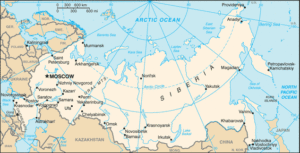 The history of the Jews in Russia and areas historically connected with it goes back at least 1,500 years. Jews in Russia have historically constituted a large religious diaspora; the vast territories of the Russian Empire at one time hosted the largest population of Jews in the world. During the early medieval times, few Jews lived in Russia. As a result of Russian expansion more than 1,200,000 Jews were incorporated under Russian rule. By 1600, the towns of Polotsk, Vitebsk, Minsk, Pinsk, Lublin, Kishinev, and Kiev had large, thriving Jewish communities. Ivan the Terrible, was antisemitic and murdered a number of Jews.
The history of the Jews in Russia and areas historically connected with it goes back at least 1,500 years. Jews in Russia have historically constituted a large religious diaspora; the vast territories of the Russian Empire at one time hosted the largest population of Jews in the world. During the early medieval times, few Jews lived in Russia. As a result of Russian expansion more than 1,200,000 Jews were incorporated under Russian rule. By 1600, the towns of Polotsk, Vitebsk, Minsk, Pinsk, Lublin, Kishinev, and Kiev had large, thriving Jewish communities. Ivan the Terrible, was antisemitic and murdered a number of Jews.
Peter the Great, however, granted Jewish bankers permits to settle in Moscow due to his ambition to modernize the country. However, this easing of restrictions was short-lived and ceased after his death, when Catherine I issued a decree banishing Jews, in 1727. Their situation changed radically, during the reign of Catherine II, when the Russian Empire acquired rule over large Lithuanian and Polish territories which historically included a high proportion of Jewish residents. In 1791, Catherine II established the Pale of Settlement, which included Poland, Lithuania, Ukraine, and the Crimea (the latter was later excluded). Its borders were finalized in 1812 with the annexation of Bessarabia. Jewish people were restricted to residence within the Pale and were required to obtain special permission to immigrate into other parts of Russia.
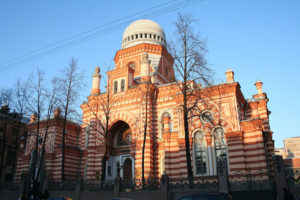 Pogrom came into frequent use as a term around 1881 after anti-Semitic violence erupted following the assassination of Czar Alexander II. Anti-Jewish groups claimed the government had approved reprisals against Jews. The first violence broke out in Yelizavetgrad, Ukraine, and then spread to 30 other towns, including Kiev. During Christmas of the same year, Russia-controlled Warsaw, Poland, exploded in violence that resulted in the death of two Jews. The stampede deaths of 29 people after a church fire was falsely blamed on Jewish pickpockets. Murderous outbreaks against Jews continued through 1884 in Belorussia, Lithuania, Rostov and Yekaterinoslav. Nizhni Novgorod hosted the final Russian pogrom of this period, resulting in the death of nine Jews. Before World War I most Jews were still confined to the Pale. At the beginning of the twentieth century this included 5,500,000 Jews living in the territory of the Russian Empire.
Pogrom came into frequent use as a term around 1881 after anti-Semitic violence erupted following the assassination of Czar Alexander II. Anti-Jewish groups claimed the government had approved reprisals against Jews. The first violence broke out in Yelizavetgrad, Ukraine, and then spread to 30 other towns, including Kiev. During Christmas of the same year, Russia-controlled Warsaw, Poland, exploded in violence that resulted in the death of two Jews. The stampede deaths of 29 people after a church fire was falsely blamed on Jewish pickpockets. Murderous outbreaks against Jews continued through 1884 in Belorussia, Lithuania, Rostov and Yekaterinoslav. Nizhni Novgorod hosted the final Russian pogrom of this period, resulting in the death of nine Jews. Before World War I most Jews were still confined to the Pale. At the beginning of the twentieth century this included 5,500,000 Jews living in the territory of the Russian Empire.
Significant pogroms in the Russian Empire included the Odessa pogroms, Warsaw pogrom (1881), Kishinev pogrom (1903), Kiev Pogrom (1905), and Białystok pogrom (1906). After the collapse of the Russian Empire in 1917, several pogroms occurred amid the power struggles in Eastern Europe, including the Lwów pogrom (1918) and Kiev Pogroms (1919). Between 1918–1919 over 1,200 pogroms took place in Ukraine, thus amounting to the greatest slaughter of Jews in Eastern Europe since 1648. On 8 August 1919, during the Polish–Soviet War, Polish troops took over Minsk in Operation Minsk. They killed 31 Jews merely suspected of supporting the Bolshevist movement, beat and attacked many more, looted 377 Jewish-owned shops (aided by the local civilians) and ransacked many private homes.
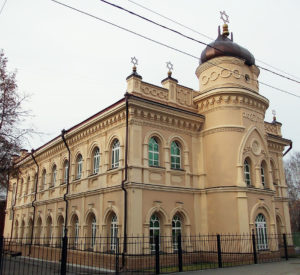 In August 1919 Jewish properties, including synagogues, were seized and many Jewish communities were dissolved. The anti-religious laws against all expressions of religion and religious education were imposed upon the Jewish population, just like on other religious groups. Many Rabbis and other religious officials were forced to resign from their posts under the threat of violent persecution. This type of persecution continued on into the 1920s. In the years leading up to World War II, there was enormous tension between the Soviet Union and Nazi Germany. Mutual distrust and suspicion dominated the political relationship between the two countries, until Hitler and Stalin shocked the world, signing a non-aggression pact in 1939, called the Molotov-Ribbentrop Treaty. This agreement defined territorial spheres of influence Germany and Russia would enjoy after invading and splitting up Poland. The Jews living in the region were caught between the territorial appetites of the two dictators. In June 1941, the short-lived Moscow-Berlin alliance came to an end with the German invasion of the Soviet Union. Operation Barbarossa, the code name given to the Axis-plan to invade and conquer the Soviet Union, saw many Russian Jews targeted and annihilated by the Nazis in the first murderous phase of the Holocaust, with the Einsatzgruppen – mobile Nazi killing units – deployed behind the front lines to annihilate Jews and communists.
In August 1919 Jewish properties, including synagogues, were seized and many Jewish communities were dissolved. The anti-religious laws against all expressions of religion and religious education were imposed upon the Jewish population, just like on other religious groups. Many Rabbis and other religious officials were forced to resign from their posts under the threat of violent persecution. This type of persecution continued on into the 1920s. In the years leading up to World War II, there was enormous tension between the Soviet Union and Nazi Germany. Mutual distrust and suspicion dominated the political relationship between the two countries, until Hitler and Stalin shocked the world, signing a non-aggression pact in 1939, called the Molotov-Ribbentrop Treaty. This agreement defined territorial spheres of influence Germany and Russia would enjoy after invading and splitting up Poland. The Jews living in the region were caught between the territorial appetites of the two dictators. In June 1941, the short-lived Moscow-Berlin alliance came to an end with the German invasion of the Soviet Union. Operation Barbarossa, the code name given to the Axis-plan to invade and conquer the Soviet Union, saw many Russian Jews targeted and annihilated by the Nazis in the first murderous phase of the Holocaust, with the Einsatzgruppen – mobile Nazi killing units – deployed behind the front lines to annihilate Jews and communists.
 Over two million Soviet Jews are believed to have died during the Holocaust, second only to the number of Polish Jews to fall victim to Hitler. Among some of the larger massacres in 1941 were: 33,771 Jews of Kyiv shot in ditches at Babi Yar; 100,000 Jews and Poles of Vilnius killed in the forests of Ponary, 20,000 Jews killed in Kharkiv at Drobnitzky Yar, 36,000 Jews machine-gunned in Odessa, 25,000 Jews of Riga killed in the woods at Rumbula, and 10,000 Jews slaughtered in Simferopol in the Crimea. Although mass shootings continued through 1942, most notably 16,000 Jews shot at Pinsk, Jews were increasingly shipped to concentration camps in German Nazi-occupied Poland. The Zmievskaya Balka massacre in 1942, coincided with the proliferation of Nazi killing efforts in the Soviet Union. In this particularly heinous event, Nazis forced about 15,000-18,000 Jews on a marching massacre that ended in mass execution by gunfire. Moreover, military success in Russia saw Hitler decide to begin deporting German Jews to the occupied Soviet Union as part of the “Final Solution” policy.
Over two million Soviet Jews are believed to have died during the Holocaust, second only to the number of Polish Jews to fall victim to Hitler. Among some of the larger massacres in 1941 were: 33,771 Jews of Kyiv shot in ditches at Babi Yar; 100,000 Jews and Poles of Vilnius killed in the forests of Ponary, 20,000 Jews killed in Kharkiv at Drobnitzky Yar, 36,000 Jews machine-gunned in Odessa, 25,000 Jews of Riga killed in the woods at Rumbula, and 10,000 Jews slaughtered in Simferopol in the Crimea. Although mass shootings continued through 1942, most notably 16,000 Jews shot at Pinsk, Jews were increasingly shipped to concentration camps in German Nazi-occupied Poland. The Zmievskaya Balka massacre in 1942, coincided with the proliferation of Nazi killing efforts in the Soviet Union. In this particularly heinous event, Nazis forced about 15,000-18,000 Jews on a marching massacre that ended in mass execution by gunfire. Moreover, military success in Russia saw Hitler decide to begin deporting German Jews to the occupied Soviet Union as part of the “Final Solution” policy.
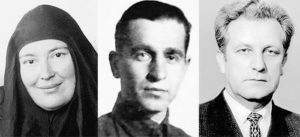 Some of righteous who gave aid to the Jews include: Mother Maria (Elizaveta Maria Skobtsova), Nikolay Kiselev and Fyodor Mikhailichenko. Mother Maria opened a house in Paris for refugees, and those who needed any help. She hid Jews there and issued them baptismal certificates, which sometimes helped save their lives. One day Mother Maria saved four Auschwitz-bound Jewish kids by hiding them in trash containers. In 1943, she was arrested and sent to Ravensbruck concentration camp, where she was was gassed a week before the concentration camp was liberated. Nikolay Kiselev lead a group of 270 Jews, mostly women, children and old men almost 1500 km eastwards to the Soviet lines. The march took 3 months and of the 270 people who left the forests near Dolginovo, 218 were saved by Nikolay Kiselev. Fyodor Mikhailichenko was sent to Germany as a forced laborer. As he spread anti-Nazi propaganda, and was sent to Buchenwald concentration camp. Two years later, a seven-year-old Jewish boy from Poland appeared at Buchenwald. Absolutely defenseless, Yurchik was condemned to die soon, if not for Fyodor, who protected, fed and clothed the child. The Jewish boy, survived and later became the Ashkenazi Chief Rabbi of Israel and Chief Rabbi of Tel Aviv.
Some of righteous who gave aid to the Jews include: Mother Maria (Elizaveta Maria Skobtsova), Nikolay Kiselev and Fyodor Mikhailichenko. Mother Maria opened a house in Paris for refugees, and those who needed any help. She hid Jews there and issued them baptismal certificates, which sometimes helped save their lives. One day Mother Maria saved four Auschwitz-bound Jewish kids by hiding them in trash containers. In 1943, she was arrested and sent to Ravensbruck concentration camp, where she was was gassed a week before the concentration camp was liberated. Nikolay Kiselev lead a group of 270 Jews, mostly women, children and old men almost 1500 km eastwards to the Soviet lines. The march took 3 months and of the 270 people who left the forests near Dolginovo, 218 were saved by Nikolay Kiselev. Fyodor Mikhailichenko was sent to Germany as a forced laborer. As he spread anti-Nazi propaganda, and was sent to Buchenwald concentration camp. Two years later, a seven-year-old Jewish boy from Poland appeared at Buchenwald. Absolutely defenseless, Yurchik was condemned to die soon, if not for Fyodor, who protected, fed and clothed the child. The Jewish boy, survived and later became the Ashkenazi Chief Rabbi of Israel and Chief Rabbi of Tel Aviv.
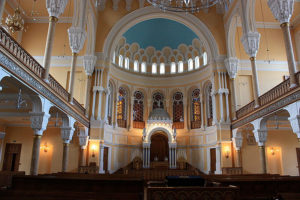 As the German invasion dragged on, Soviet resistance stiffened, with the epic Battle of Stalingrad, 1942-1943, holding off the Nazis and ultimately expelling the Nazi invaders. The revival of Jewish identity after the war, stimulated by the creation of the state of Israel in 1948, was cautiously welcomed by Stalin as a means to put pressure on Western imperialism in the Middle East, but when it became evident that many Soviet Jews expected the revival of Zionism to enhance their own aspirations for separate cultural and religious development in the Soviet Union, a wave of repression was unleashed. Even after Stalin’s death, the attempt to suppress Judaism and Jewish culture continued. The few Jews who continued participation in Jewish life were called refusniks, and were severely punished by the Soviet authorities. By 1965, only about 60 synagogues remained in all of Russia.
As the German invasion dragged on, Soviet resistance stiffened, with the epic Battle of Stalingrad, 1942-1943, holding off the Nazis and ultimately expelling the Nazi invaders. The revival of Jewish identity after the war, stimulated by the creation of the state of Israel in 1948, was cautiously welcomed by Stalin as a means to put pressure on Western imperialism in the Middle East, but when it became evident that many Soviet Jews expected the revival of Zionism to enhance their own aspirations for separate cultural and religious development in the Soviet Union, a wave of repression was unleashed. Even after Stalin’s death, the attempt to suppress Judaism and Jewish culture continued. The few Jews who continued participation in Jewish life were called refusniks, and were severely punished by the Soviet authorities. By 1965, only about 60 synagogues remained in all of Russia.
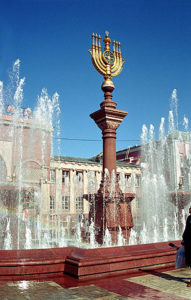 It was only in the late 1980s, under Mikhail Gorbachev’s perestroika, that the situation improved for Russia’s Jews, who were finally permitted to practice their religion and cultural activities and given the right to emigrate. Many synagogues and Jewish schools reopened across Russia and the former Soviet republics. In 1989 a record 71,000 Soviet Jews were granted exodus from the USSR, most leaving for Israel, and the West: Germany, the United States, Canada, and Australia. Since the 1970s, over 1.1 million Russians of Jewish origin have emigrated.
It was only in the late 1980s, under Mikhail Gorbachev’s perestroika, that the situation improved for Russia’s Jews, who were finally permitted to practice their religion and cultural activities and given the right to emigrate. Many synagogues and Jewish schools reopened across Russia and the former Soviet republics. In 1989 a record 71,000 Soviet Jews were granted exodus from the USSR, most leaving for Israel, and the West: Germany, the United States, Canada, and Australia. Since the 1970s, over 1.1 million Russians of Jewish origin have emigrated.
Today, Moscow today is home to about 20 synagogues. The iconic Choral Synagogue has been refurbished and attracts scores of worshippers each Shabbat. In St. Petersburg, Jewish life has been revived as well with synagogues, a Jewish Community Centre, and schools. In November 2012, the Jewish Museum and Tolerance Centre, one of the world’s biggest museums of Jewish history, opened in Moscow. Some have described a ‘renaissance’ in the Jewish community inside Russia since the beginning of the 21st century. In 2016, there were 179,500 Jews in Russia.